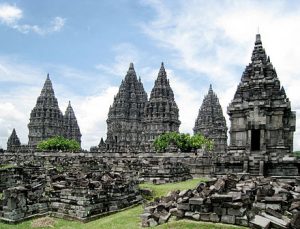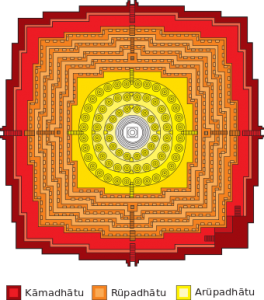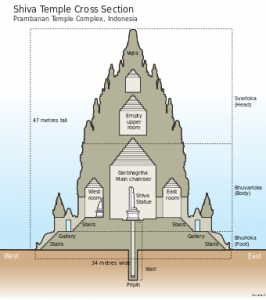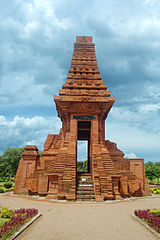Candi
A candi is a Hindu or Buddhist temple in Indonesia, mostly built during the Zaman Hindu-Buddha or “Hindu-Buddhist period” between circa the 4th and 15th centuries.
In contemporary Indonesian Buddhist perspective, candi also refers to a shrine, either ancient or new. Several contemporary viharas in Indonesia for example, contain the actual-size replica or reconstruction of famous Buddhist temples, such as the replica of Pawon and Plaosan’s perwara (small) temples. In Buddhism, the role of a candi as a shrine is sometimes interchangeable with a stupa, a domed structure to store Buddhist relics or the ashes of cremated Buddhist priests, patrons or benefactors. Borobudur, Muara Takus and Batujaya for example are actually elaborate stupas.
Terminology
Candi refers to a structure based on the Indian type of single-celled shrine, with a pyramidal tower above it, and a portico.[7] The term Candi is given as a prefix to the many temple-mountains in Indonesia, built as a representation of the Cosmic Mount Meru, an epitome of the universe. However, the term also applied to many non-religious structures dated from the same period, such as gapura (gates), petirtaan (pools) and some of habitation complexes. Examples of non-temple candis are the Bajang Ratu and Wringin Lawang gates of Majapahit. The “Candi Tikus bathing pool” in Trowulan and Jalatunda in Mount Penanggungan slopes, as well as the remnants of non-religious habitation and urban structures such as Ratu Boko and some of Trowulan city ruins, are also considered candi.
In ancient Java, a temple was probably originally called prāsāda (Sanskrit: प्रासाद), as evidence in the Manjusrigrha inscription (dated from 792 CE), that mentioned “Prasada Vajrasana Manjusrigrha” to refer to the Sewu temple.[8]:89 This term is in par with Cambodian and Thai term prasat which refer to the towering structure of a temple.

Prambanan temple compound. The towering candi prasada (temple towers)[6] are believed to represent the cosmic Mount Meru, the abode of gods.
Architecture
The candi architecture follows the typical Hindu architecture traditions based on Vastu Shastra. The temple layout, especially in Central Java period, incorporated mandala temple plan arrangements and also the typical high towering spires of Hindu temples. The candi was designed to mimic Meru, the holy mountain the abode of gods. The whole temple is a model of Hindu universe according to Hindu cosmology and the layers of Loka.
Structure elements
The candi structure and layout recognize the hierarchy of the zones, spanned from the less holy to the holiest realms. The Indic tradition of Hindu-Buddhist architecture recognize the concept of arranging elements in three parts or three elements. Subsequently, the design, plan and layout of the temple follows the rule of space allocation within three elements; commonly identified as foot (base), body (center), and head (roof). The three zones is arranged according to a sacred hierarchy. Each Hindu and Buddhist concepts has their own terms, but the concept’s essentials is identical. Either the compound site plan (horizontally) or the temple structure (vertically) consists of three zones:[13]
- Bhurloka (in Buddhism: Kāmadhātu), the lowest realm of common mortals; humans, animals also demons. Where humans still bound by their lust, desire and unholy way of life. The outer courtyard and the foot (base) part of each temples is symbolized the realm of bhurloka.
- Bhuvarloka (in Buddhism: Rupadhatu), the middle realm of holy people, rishis, ascetics, and lesser gods. People here began to see the light of truth. The middle courtyard and the body of each temples is symbolized the realm of bhuvarloka.
- Svarloka (in Buddhism: Arupadhatu), the highest and holiest realm of gods, also known as svargaloka. The inner courtyard and the roof of each temples is symbolized the realm of svarloka. The roof of Hindu structure usually crowned with ratna (sanskrit: jewel) or vajra, or in eastern Java period, crowned by cube structure. While stupa or dagoba cylindrical structure served as the pinnacle of Buddhist ones.

Borobudur ground plan taking the form of a Mandala

The Shiva temple Candi Prambanan consist of three ascending realms, temple’s base (Bhurloka), body (Bhurvaloka) and roof (Svarloka).

